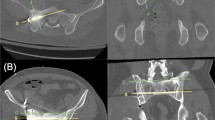Abstract
Objective
The purpose of this study was to evaluate retrospectively the safety and effectiveness of the computed tomography (CT) fluoroscopy-guided placement of iliosacral screws in patients with unstable posterior pelvic fractures.
Materials and methods
Six patients (four women and two men; mean age 55.8 years; range 35–77 years) with unstable posterior pelvic fractures underwent iliosacral screw placement under CT fluoroscopy guidance between November 2007 and August 2008. Unstable pelvic ring injury (AO types B and C) was the indication for this procedure.
Results
In all the six patients except one, CT fluoroscopy-guided placement had been technically successful. In one patient, a second screw had been inserted, with a tilt to the caudal site, and slightly advanced into the extrasacral body; afterward, it could be exchanged safely for a shorter screw. Five patients and one patient underwent placement of two screws and one screw, respectively. The mean duration of the procedure was 15.0 min (range 9–30 min) per screw; the duration was 12.3 min and 18.2 min for the first and second screws, respectively. No complications requiring treatment occurred during or after the procedure. The mean clinical and radiologic follow-up period was 14 months (range 6–21 months). All pelvic injuries had healed satisfactorily, without complication, and all patients are now doing well clinically and can walk.
Conclusion
CT fluoroscopy-guided placement of iliosacral screws is a safe and effective treatment in patients with unstable posterior pelvic fractures.

Similar content being viewed by others
References
Routt ML, Simonian PT, Mills WJ. Iliosacral screw fixation: early complications of the percutaneous technique. J Orthop Trauma. 1997;11:584–9.
Keating JF, Werier J, Blachut P, Broekhuyse H, Meek RN, O’Brien PJ. Early fixation of the vertically unstable pelvis: the role of iliosacral screw fixation of the posterior lesion. J Orthop Trauma. 1999;13:107–13.
Ziran BH, Smith WR, Towers J, Morgan SJ. Iliosacral screw fixation of the posterior pelvic ring using local anaesthesia and computerized tomography. J Bone Joint Surg Br. 2003;85:411–8.
Sciulli RL, Daffner RH, Altman DT, Altman GT, Sewecke JJ. CT-guided iliosacral screw placement: technique and clinical experience. AJR Am J Roentgenol. 2007;188:W181–92.
Jacob AL, Messmer P, Stock K, et al. Posterior pelvic ring fractures: closed reduction and percutaneous CT-guided sacroiliac screw fixation. Cardiovasc Intervent Radiol. 1997;20:285–94.
Blake-Toker A, Hawkins L, Nadalo L, et al. CT guided percutaneous fixation of sacroiliac fractures in trauma patients. J Trauma. 2001;51:1117–21.
Carlson SK, Bender CE, Classic KL, et al. Benefits and safety of CT fluoroscopy in interventional radiologic procedures. Radiology. 2001;219:515–20.
Daly B, Templeton PA. Real-time CT fluoroscopy: evolution of an interventional tool. Radiology. 1999;211:309–15.
Young JW, Burgess AR, Brumback RJ, Poka A. Pelvic fractures: value of plain radiography in early assessment and management. Radiology. 1986;160:445–51.
Orthopaedic Trauma Association. Fracture and dislocation compendium. Orthopaedic Trauma Association Committee for Coding and Classification. J Orthop Trauma. 1996;10(Suppl 1):69.
Ebraheim NA, Rusin JJ, Coombs RJ, Jackson WT, Holiday B. Percutaneous computed-tomography-stabilization of pelvic fractures: preliminary report. J Orthop Trauma. 1987;1:197–204.
Hiraki T, Mimura H, Gobara H, et al. CT fluoroscopy-guided biopsy of 1000 pulmonary lesions performed with 20-gauge coaxial cutting needles: diagnostic yield and risk factors for diagnostic failure. Chest (in press).
Katada K, Kato R, Anno H, et al. Guidance with real-time CT fluoroscopy: early clinical experience. Radiology. 1996;200:851–6.
Yueh N, Halvorsen RA, Letourneau JG, Grass JR. Gantry tilt technique for CT-guided biopsy and drainage. J Comput Assist Tomogr. 1989;13:182–4.
Author information
Authors and Affiliations
Corresponding author
Additional information
This work received no financial support from organizations with a financial interest in the subject matter, nor were there any potential conflicts of interest.
Rights and permissions
About this article
Cite this article
Iguchi, T., Ogawa, KI., Doi, T. et al. Computed tomography fluoroscopy-guided placement of iliosacral screws in patients with unstable posterior pelvic fractures. Skeletal Radiol 39, 701–705 (2010). https://doi.org/10.1007/s00256-009-0826-3
Received:
Revised:
Accepted:
Published:
Issue Date:
DOI: https://doi.org/10.1007/s00256-009-0826-3




